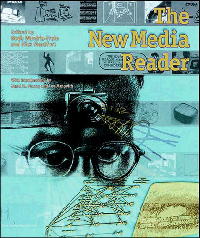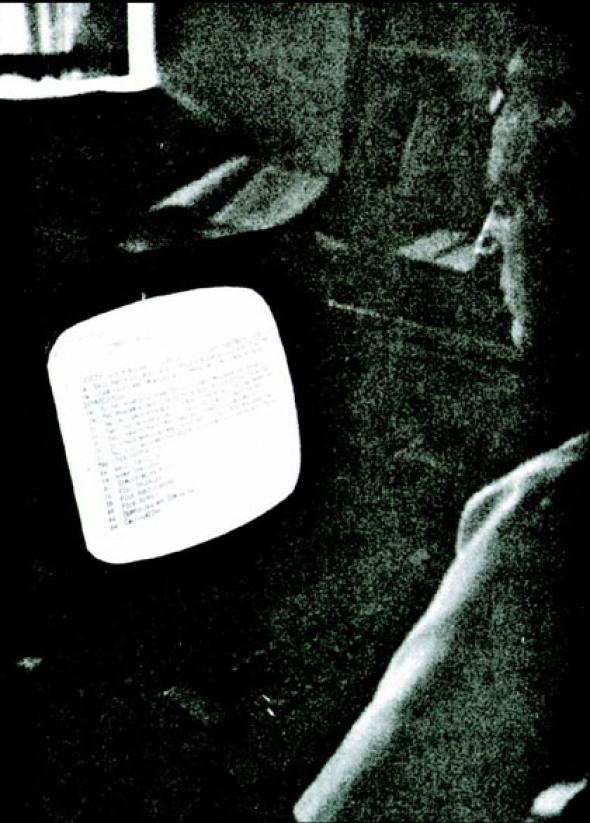The New Media Reader
This hefty tome aspires to ‘chronicle the history’ and ‘form the foundation’ of the field of new media. It is a chronological collection of texts by computer scientists, architects, designers and cultural critics as well as visual artists, poets and novelists. The earliest text dates back to 1941 (The Garden of Forking Paths, by J.L. Borges) and the book closes with an essay on the World Wide Web by Tim Berners-Lee (1994). Narrating the succession of technological innovations, the editors track their development through texts in which inventions such as the mouse, the internet, hypertext and AI characters were first conceived. The reader is comprised of four sections, although the texts within each often seem unrelated to the sections’ titles, with the selection criteria left unexplained. A CD-Rom accompanies the book containing early games, software, digital art, poetry and digitised-video versions of software of which no operational version exists today.
 Edited by a Fellow in Creative Writing at Brown University and a PhD student in Information Science at Pennsylvania University, the targeting of an American, uninitiated, primarily student audience is evident in introductions which tend to contextualise the largely American-authored texts in their contemporary US, rather than global, setting. The editors’ academic background may also explain their preference for texts that emphasise the process of creativity and invention over ones that would analyse such inventions historically and politically.
Edited by a Fellow in Creative Writing at Brown University and a PhD student in Information Science at Pennsylvania University, the targeting of an American, uninitiated, primarily student audience is evident in introductions which tend to contextualise the largely American-authored texts in their contemporary US, rather than global, setting. The editors’ academic background may also explain their preference for texts that emphasise the process of creativity and invention over ones that would analyse such inventions historically and politically.



This is nevertheless an encyclopaedic project, with explanatory footnotes on almost every page of original text, and its own cross-referrential system which links technical, theoretical and literary passages. The book’s two general introductions by Janet Murray and Lev Manovich don’t do justice to the wealth and density of material to be found here: Murray reduces the political debate surrounding new technologies to a mere technophilia/technophobia use/abuse issue, while Lev Manovich sweepingly and authoritatively insists that ‘new media’ should be defined as distinct from ‘cyberculture’, presumably because it engages with the cultural but not the social, computing but not networking. The editors’ own introductions to the individual texts are much more illuminating and carefully thought out, providing detailed background of authors’ work, with further historical contextualisation achieved through the cross-referencing - mimicking a map of hyperlinked documents. Most useful is this juxtaposition of accounts of technological creativity and related cultural critique, and the addition of commentary on the links between texts. Reading Douglas Engelbart’s hierarchical organisation of his plan for the design and function of the mouse in the light of Deleuze and Guattari’s theorisation of non-hierarchical interconnected structures is a particularly revealing in this respect, contradicting the current ideological orthodoxy of unproblematic congruence between radical philosophy and science.
Articulating a genealogy of new media, an ambition the editors proclaim in the preface, is not a feasible task for a one-volume interdisciplinary reader. The result is that, despite the richness of information it provides, the selected content is rather lopsided. More conducive to a historical analysis of the cultural and aesthetic than the social and political aspects of technological innovations, the emphasis is on human-computer interaction, rather than human communication by means of networked machines.
The New Media Reader // Noah Wardrip-Fruin and Nick Montfort // MIT Press (Book and CD-Rom edition) // 2003 // ISBN: 0262232278 // 823 pages // Hardcover £29.95 & $45.00
Mute Books Orders
For Mute Books distribution contact Anagram Books
contact@anagrambooks.com
For online purchases visit anagrambooks.com








